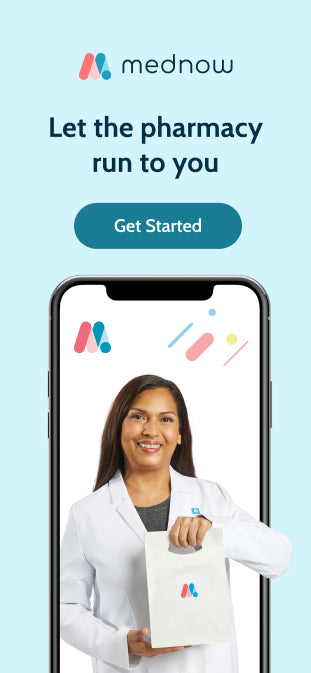Introduction
Headaches seem to be a universal human experience. We'll all get a headache at some point in our lives. Sometimes the cause of a headache is easy to pinpoint: anxiety, atmospheric pressure, dehydration, lack of sleep or other health issues. Sometimes not so much.
A headache is typically a minor complaint but frequent sufferers will attest, they be debilitating. If headaches are persistent or progressing in severity, it's time to seek professional care from a family doctor or online using a service like Mednow Virtual Care.
What is a headache?
Headache is a (you guessed it) ache that occurs anywhere in the (wait for it) head. According to The World Health Organization (WHO), headache disorders — persistent headaches — are among the most frequent nervous system disorders.

What triggers headaches?
Headaches can be triggered by a number of factors. If you're suffering from persistent headaches, it helps to understand any contributing factors so you can mitigate them. While medication (prescription or over the counter pain relief) can offer respite, we ideally want to address the cause of headaches as opposed to just treating symptoms.
Some common headache triggers include:
- Psychological factors including stress (job, home, and family), anxiety, and depression.
- Physical factors including sleep disturbances and a sedentary lifestyle.
- Dietary factors including poor nutrition, alcohol, aspartame, cheese, red wine, chocolate, caffeine (intake or withdrawal), skipping meals.
- Hormonal factors including menstruation, menopause, contraceptive pills, or hormone replacement treatment.
The different types of headache
Primary headache disorder
Primary headache disorder effectively means that the headache itself is the problem. i.e. it's not a symptom or marker of another condition or disease. The following are the most frequent primary headaches:
Migraine headaches
The earmarks of migraine headaches are repeated throbbing or pulsing pain with of moderate to severe intensity. Migraine headaches are can be debilitating, as any sufferer can attest. Symptoms of migraine headaches can include nausea, vomiting, and sensitivity to light and sound. Migraine headaches can last for four to 72 hours.
Tension headaches
A tension headache is what we might consider a "common" headache. These headaches can be linked to posture and can be caused by stress, anxiety and depression. A tension headache is typically a steady as opposed to throbbing or pulsing ache. Tension headaches can feel like they're localized in one area or can be a more "all-over" pain or discomfort. As with migraines, tension headaches can last hours or even several days.
Cluster headaches
A "cluster headache" is often called a histamine response headache. These headaches can be caused by an allergen or intake of tyramine-rich foods like wine, beer, cheese, coffee and chocolate. Cluster headaches are typically localized and relatively short in duration. As it's often an allergic reaction, a cluster headache might be accompanied by other allergy symptoms including runny nose, itchiness and eye redness. Cluster headaches can also be triggered by stress and lack of sleep.
Secondary headache disorder
Headache is considered "secondary" when it's a symptom of an underlying medical condition that stimulates the pain-sensitive nerves in the head.
13 natural remedies and interventions for headache relief
Now that we're familiar with the term, what can we do relieve a headache or, better yet, avoid headaches altogether?
-
Drink water
Clinical research links chronic and moderate dehydration with headaches. Staying hydrated is always good advice. Proper hyrdration can help avoid headaches and can lessen the intensity and duration of a headache.
Keep a water bottle nearby to drink water throughout the day and choose high-water content foods such as vegetables and fruits.
-
Limit alcohol
Most of us probably don't need the clinical studies to make a link between alcohol and headaches. Alcohol It's a vasodilator, which means it expands blood vessels, which can in turn cause headaches.
Alcohol is also a diuretic, meaning it triggers the body to release water. Moderate dehydration is one symptom of an alcohol "hangover..." and we've already established that proper hydration is key to avoiding or mitigating headaches.
-
Get restful sleep
The link between headache and sleep is complicated. Migraines can be triggered by both a lack of sleep or its opposite — excessive sleep. Patients with chronic headaches are more likely to have insomnia.
What isn't complicated is this: most adults need between seven and nine hours of restful sleep every 24 hours.
-
Don't Skip Meals
Going too long between meals or skipping meals altogether can trigger headaches. Low blood glucose levels can induce migraine or hypoglycaemic headaches. Eating regular, nutritious meals and snacks is good advice any time.
-
Get enough magnesium
Incorporating magnesium-rich foods (whole grains, legumes, dark leafy greens, avocados) can also help mitigate headaches. Health Canada recommendations vary on gender, age and other factors but broad strokes, aim for 300mg/day for women and 400mg/day for men.
-
Drink herbal tea
Having a warm cup of tea will help ease headache symptoms regardless of the type of headache you experience.
Ginger tea, for example, has an antioxidant effect that can help relieve migraine pain. Willow bark tea is another herbal beverage that includes an active ingredient called salicin, a chemical compound similar to aspirin.
-
Try essential oils
Essential oils are concentrated liquids extracted from a plant's leaves, stems, blossoms, or other parts.
Some people report lavender essential oil as helpful in easing the symptoms of a headache and migraine pain. Likewise, some suggest chamomile oil, peppermint oil and rosemary oil as helpful to relieve headache symptoms.
-
Acupuncture
Acupuncture uses needles inserted into a patient's skin to induce a therapeutic effect. It's a traditional Chinese medecine treatment for headaches and other pains.
At the hands of an conscientious practitioner using sterile needles and taking care, acupuncture is, at worst, harmless. At best, it's an effective and widely available alternative therapy that helps headache suffers find relief.
-
Relax!
Relaxation practices, including yoga and meditation, have been shown to reduce the frequency and intensity of headaches. With stress and posture as known headache triggers, it stands to reason.
-
Avoid food triggers
Migraine and tension headaches can be triggered by certain foods such as cheese, chocolate, and coffee. An elimination diet — experimenting by removing a given food or potential trigger — can help you hone in on any foods that might trigger your headaches. -
Avoid gum
Excessive gum chewing can cause migraine and tension headaches. If you suffer from headaches and you chew gum regularly, cut the gum for a couple of weeks to see if perhaps it's causing or exacerbating your headaches.
-
Take a nap
We talked about sleep in the third tip and relaxation in the ninth tip on this list. A nap offers a bit of both. If you're stressed or overtired and feel a headache coming on, a nap may be just the ticket.
-
Prioritize Omega-3s
Essential fatty acids are required by your body and we can't make them on our own. Headaches can be a symptom of a diet low in omega-3 fatty acids.
Flaxseeds, salmon, walnuts, tuna, and eggs are all high in omega-3 fatty acids.
When to see a doctor about your headaches
Often, a headache is a nuisance or our bodies telling us to slow down. However, frequent or severe headaches or sudden onset of persistent headaches can point to a more serious health condition. You know your body best. If you have a severe headache that is accompanied by the following symptoms, you should speak to a doctor:
- Fainting
- Difficulty of speaking
- High fever
- Numbness or paralysis on one side of your body
- Stiff neck
- Nausea or vomiting
Speak to a doctor
Mednow Virtual Care is a simple and secure way to connect with a licensed Canadian doctor or nurse practitioner online or over the phone. Mednow Virtual Care clinicians can offer medical advice, diagnose and treat a variety of health conditions. Mednow Virtual Care may not be available in all provinces.
This article offers general information only and is not intended as medical or other professional advice. A healthcare provider should be consulted regarding your specific situation. While the information presented is believed to be factual and current, its accuracy is not guaranteed, and it should not be regarded as a complete analysis of the subjects discussed. All expressions of opinion reflect the judgement of the authors as of the date of publication and are subject to change. No endorsement of any third parties or their advice, opinions, information, products or services is expressly given or implied by Mednow or its affiliates.
Commencer
